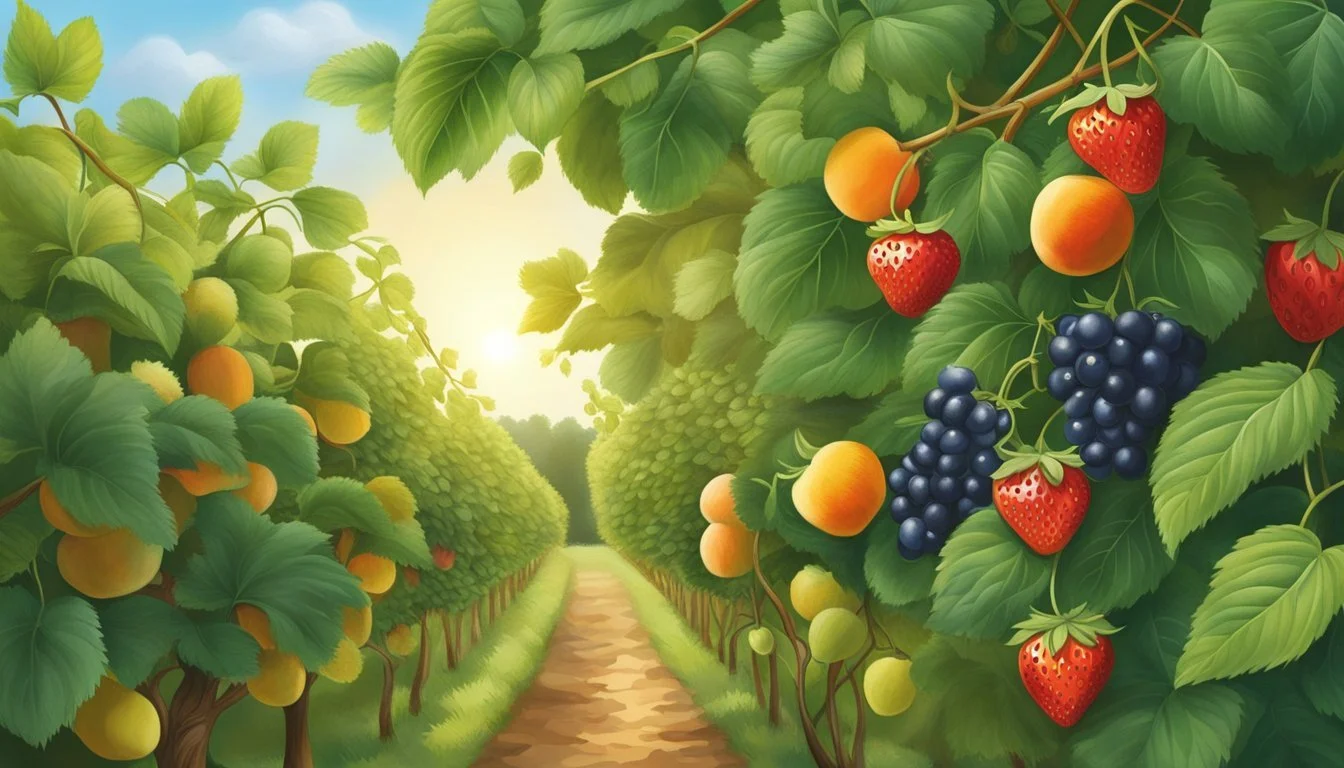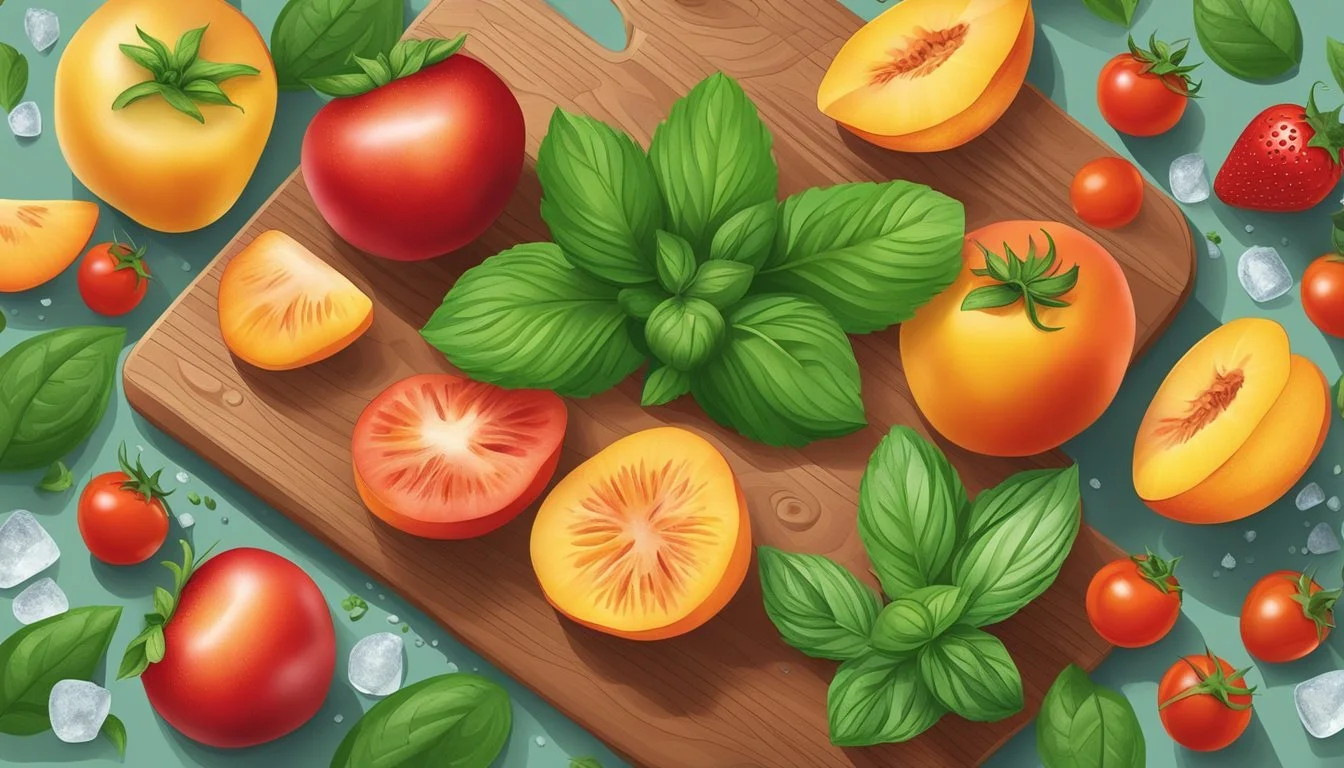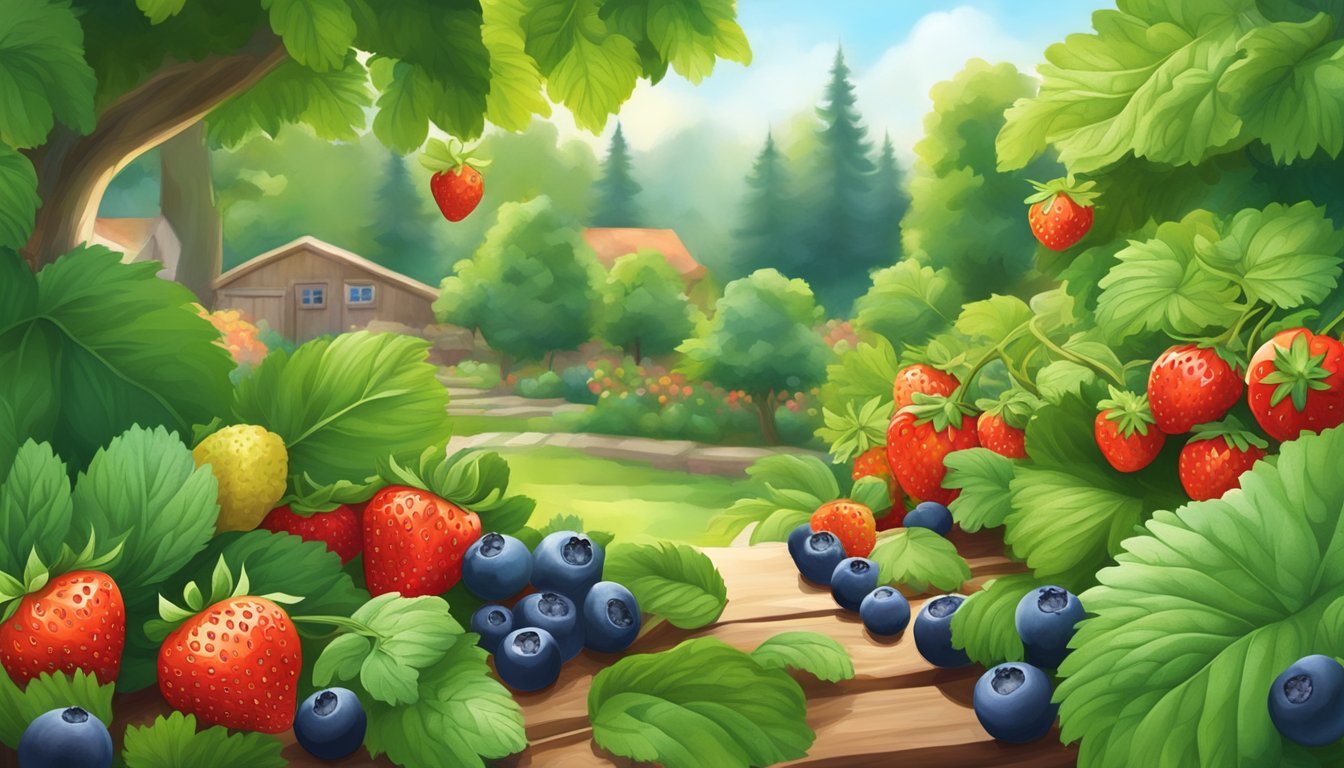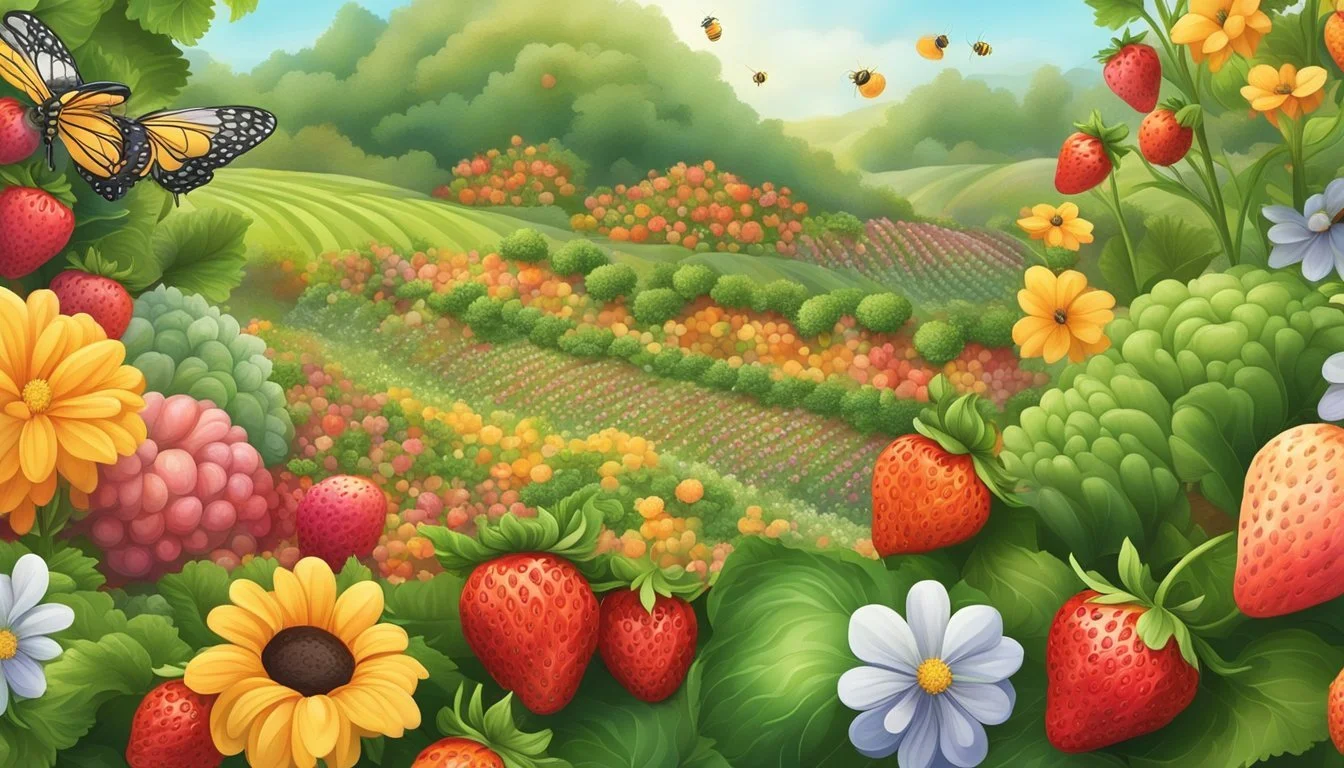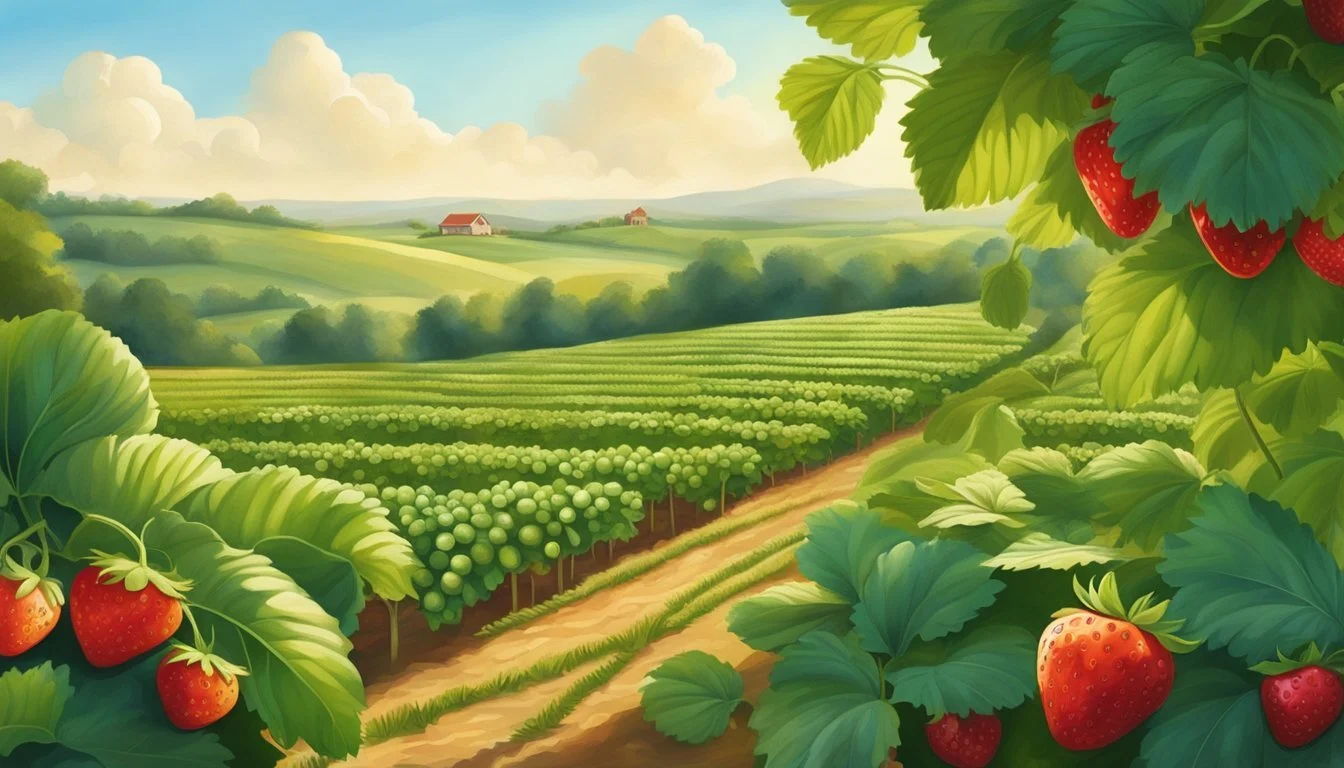Virginia Seasonal Fruit & Vegetables in June
What’s Fresh?
This Article is Part of our Virginia Seasonal Fruit & Veg Calendar
June marks a vibrant time in Virginia as gardens and farms burst with a bounty of fresh fruits (What wine goes well with fruit?) and vegetables. Strawberries begin winding down in early June, passing the baton to a variety of produce that reaches peak ripeness under the warm summer sun. The state's temperate climate and fertile soil create ideal conditions for growing a plethora of crops, from sweet berries to crisp vegetables.
During this month, residents and visitors alike can enjoy the flavors of fresh cucumbers, which begin their season in June and remain available through November. Eggplants also make their seasonal debut, ready for harvest through August. These join the ongoing harvest of spring vegetables and set the stage for summer's abundant selection.
Virginia's farms offer an extensive range of produce that continues into June, including the tender greens of spinach, the versatile broccoli, and a colorful array of berries like blackberries (how long do blackberries last?) and blueberries. This variety not only provides culinary delight but also supports a dietary balance, offering a wealth of nutrients and flavors to explore.
Understanding Seasonality
The concept of seasonality revolves around the time of year when fruits and vegetables are at their peak in terms of flavor and nutrition. This section explores what defines seasonal produce and the advantages of integrating these items into one's diet during their peak seasons.
Defining Seasonal Produce
Seasonal produce refers to fruits and vegetables that are naturally at the harvesting stage in their natural growing cycle. In Virginia, seasonal produce aligns with the climatic changes, resulting in a variety of produce specific to the time of year. For instance, summer brings an abundance of tomatoes and watermelons, while fall ushers in turnips and winter squash. Consuming produce in season means enjoying these items during spring, summer, fall, or winter when they are fresh and abundant.
Benefits of Eating Seasonally
Eating seasonally offers numerous benefits. Produce harvested in season is typically fresher, more flavorful, and often more nutritious than out-of-season counterparts shipped from far away. Additionally, choosing seasonal items can lead to cost savings, as the abundance of produce typically drives prices down. For example, purchasing strawberries during their peak season in spring and early summer ensures optimal taste and affordability.
Seasonal eating also supports local farming communities and minimizes the environmental impact associated with long-distance transportation. Thus, consumers can take pride in sustaining local agriculture and reducing their carbon footprint when they choose seasonal fruits and vegetables.
June's Harvest Timeline
June in Virginia offers a diverse range of fresh produce, with each phase of the month ushering in a new selection of fruits and vegetables.
Early June Offerings
Strawberries: Peak season continues from May.
Cherries (how long do cherries last?): Begin to make their sweet debut.
Beets: Earthy and deep red, beets are ready for harvest.
Lettuce: Fresh leaves are in abundance.
Mid-June Abundance
Blueberries: Juicy and ripe for the picking.
Peaches: Start to appear, with their fuzzy exterior and sweet flesh.
Summer squash: Zucchinis and yellow squash are prolific.
Cucumbers: Crisp and perfect for salads.
Late June Additions
Blackberries: Berries turn plump and deeply colored.
Tomatoes: Begin to ripen, promising a full-flavor burst.
Corn: Sweet ears are just starting to be ready.
Green Beans: Snap beans are tender and abundant.
Fruit Highlights in June
June is a pivotal month for fruit enthusiasts in Virginia, offering the start of the season for several beloved fruits, including strawberries, blueberries, cherries, peaches, and a variety of melons.
Berries on the Rise
Strawberries: June is the tail end of the strawberry season, with fruits being especially sweet and ripe.
Blueberries: They begin to make their appearance in markets around June, providing a fresh, antioxidant-rich treat.
Stone Fruit Sensations
Cherries: Late spring and early summer herald in the cherry season, with June presenting the perfect time to enjoy these small stone fruits.
Peaches: Peaches start to become available in June, signalling the approach of summer with their juicy, fragrant flesh.
Melon Varieties
Watermelon: Known for their hydrating and sweet properties, watermelons start to arrive in June.
Cantaloupe (how long does cantaloupe last?): This melon variety also graces the markets in June, offering a softer, creamier alternative to its more watery cousin.
Vegetable Picks for June
June in Virginia brings a plethora of vegetables to the table, ranging from fresh leafy greens to a variety of savory root vegetables and the beginning of the vibrant summer squash season.
Leafy Greens Galore
Virginia's June gardens are lush with leafy greens. Arugula (how long does arugula last?) and lettuce are at their prime, offering a crisp and flavorful base for salads. Harvesting of spinach also continues before the summer heat sets in. Farmers' markets brim with these greens, signifying their peak freshness.
Arugula
Spinach
Lettuce varieties
Savory Roots & Shoots
Root vegetables such as beets and carrots offer deep, earthy flavors and are ideal for roasting or adding crunch to salads. Peas, especially sugar snap and snow peas, are sweet and crisp, perfect for snacking or light cooking.
Beets
Carrots
Peas (sugar snap, snow)
Summer Squash & Cucumbers
June marks the start of summer squash season, with zucchini and yellow squash being widely available. They are best when harvested young and tender. Cucumbers also make their debut, refreshing and perfect for salads or pickling.
Zucchini
Yellow Squash
Cucumbers
Herbs and More
During the month of June, Virginia's gardens are abundant with a variety of herbs and alliums, each offering unique flavors and benefits. Enthusiasts can find basil (how long does basil last?), an essential in Italian cooking, growing prolifically. It's excellent for pesto or as a fresh addition to salads and pastas.
Cilantro, often used in Mexican and Asian cuisine, also thrives in June. The fresh, citrusy leaves can be chopped into salsas, rice, or used as a garnish. Dill (how long does dill last?), with its feathery fronds, imparts a distinct aroma and taste, especially cherished in pickling processes or when paired with fish dishes.
The refreshing mint variety peaks during this time, ideal for infusing drinks, making mojitos, or adding a cool touch to desserts. With its medicinal and culinary uses, sage makes its presence known in June. It is bold in flavor, often paired with meats or incorporated into stuffings.
Thyme, a versatile herb, offers a subtle earthiness to dishes, well-loved for its use in marinades, soups, and stews.
In addition to herbs, Virginia in June is rich with alliums. Garlic bulbs are ready for harvest, imparting pungent flavors essential in countless recipes. Onions and shallots also mature, their versatility evident as they form the backbone of flavors in savory dishes. Finally, scallions add mild zest to dishes, whether grilled, sautéed, or used raw as a topping.
A quick guide to these June gems:
Herbs:
Basil: Fresh, aromatic
Cilantro: Citrusy, vibrant
Dill: Delicate, tangy
Mint: Cool, invigorating
Sage: Pine-like, earthy
Thyme: Subtle, versatile
Alliums:
Garlic: Pungent, essential
Onions: Robust, foundational
Shallots: Mild, refined
Scallions: Zesty, fresh
Gardeners and cooks honor these offerings by incorporating them into seasonal dishes, relishing in the freshness that only June can provide.
Virginia's Seasonal Calendar
Virginia offers a diverse range of fruits and vegetables that come into season in June, each reflecting the state's rich agricultural tradition. The onset of summer in Virginia brings with it a bountiful variety of fresh produce harvested across the commonwealth.
Fruits that are typically at their peak in June include:
Strawberries: Early June sees the tail end of the strawberry season.
Blueberries: June marks the beginning of the blueberry season in Virginia.
Blackberries: The month heralds the start of blackberry availability.
Peaches: Stone fruit lovers can start enjoying Virginia peaches in June.
Meanwhile, vegetables become widely available during this time as well, with many crops reaching their optimal freshness. Virginia’s most commonly available vegetables in June are:
Summer Squash: Includes a variety of squashes such as zucchini and yellow squash.
Cucumbers: These are cool, crisp, and perfect for summer salads.
Tomatoes: By June, tomatoes start ripening and are ready for harvest.
Green Beans: Snap beans often come into season now.
Beets: Both the beetroot and the greens are usually available.
Crop availability can vary from year to year due to factors such as weather conditions and planting schedules, but typically, Virginia's June harvest remains quite consistent, offering fresh, flavorful, and nutrient-rich choices for consumers. Buyers are encouraged to take advantage of these seasonal offerings, supporting Virginia's farming community and enjoying produce at its peak freshness and nutritional value.
Pairings and Flavor Combinations
June in Virginia offers a vibrant palette of fresh produce that inspires delightful pairings and flavor combinations. This month's harvest allows for a variety of nuanced tastes in both raw and cooked forms.
Strawberries are at their peak, and they naturally complement the tartness of rhubarb in pies and crumbles. Their sweetness is equally enhanced by the fresh, peppery notes of arugula in salads, blending beautifully with a balsamic reduction.
For cucumbers, their crisp texture and refreshing taste pair well with the fatty richness of avocados. They excel sliced in salads or as the perfect cooling complement to spicy dishes. One can also consider the combination of cucumbers with dill and yogurt in creamy summer soups.
When it comes to corn, its sweet kernels are a classic match for bold, savory flavors. They can be roasted to create a charred, smoky profile that pairs exceptionally with herbs like cilantro and thyme. A salad incorporating corn, cherry tomatoes, and feta would showcase the sweetness of the vegetable alongside the tang and saltiness of the cheese.
Eggplants hold a smoky depth when roasted, acting as a hearty base for various flavor profiles. An example is the pairing with garlic and tomatoes, creating a rich, Mediterranean-inspired dish. They also absorb flavors like curry and basil well, making them versatile for multiple recipes.
The union of these ingredients introduces a bright array of flavors encouraging experimentation and enjoyment of Virginia's June bounty.
Preserving and Extending Seasonality
As June's bounty arrives in Virginia, preserving the harvest ensures the enjoyment of flavors throughout the year. Techniques such as canning and employing season extension methods can maximize the use of local produce like berries and vegetables.
Canning and Preserving Methods
Canning is a viable way to capture the peak ripeness and flavors of fruits and vegetables. For instance, berry jams and fruit pies fillings can be made in June and preserved to be savored long after their season ends. Careful attention to sanitation and following trusted canning guidelines are crucial for safety and quality.
Strawberries: Ideal for jams or pie fillings.
Blueberries: Suitable for jams and also to be canned as preserves.
Cherries: Can be preserved whole or as part of sweet or savory preserves.
Pickling is another preserving approach for many vegetables. From classic cucumber pickles to spicy pickled peppers, this method extends the shelf life of produce while adding a zesty flavor.
Cucumbers: Classic pickling choice, often with dill and garlic.
Beets: Can be pickled for a sweet and tangy condiment.
Peas: Pickle with mint to create a unique snack.
Freezing preserves the quality of many fruits and vegetables when they are at their freshest. It is particularly useful for items like mango, which is not locally grown in Virginia but can be bought in peak season from other regions, or for overripe local berries that might not be ideal for canning.
Season Extension Techniques
In Virginia, innovative season extension techniques are employed by gardeners and farmers to prolong the harvest of certain crops beyond their standard growing seasons.
Hoophouses and High Tunnels: These structures shelter plants from the elements, allowing for earlier planting and later harvesting.
Cold Frames and Row Covers: These can protect crops during unexpected cold snaps, extending the growing season into the cooler months.
Mulching: Helps to regulate soil temperature and retain moisture, benefiting plants during fluctuations in weather.
Shopping Tips for Fresh Produce
When seeking the freshest fruits and vegetables in June in Virginia, one's prime focus should be on the abundance and peak quality available. Seasonality is key to both flavor and nutritional content, and navigating local markets and understanding product labels are crucial steps in making informed choices.
Local Markets and Co-ops
Local markets offer a bounty of just-harvested produce, ensuring availability of fruits and vegetables at their peak. Shoppers should prioritize:
Farmers markets: Direct access to freshly picked produce which is often organic and non-GMO.
Community-Supported Agriculture (CSA): Subscription to a farm's harvest can yield a diverse array of seasonal produce.
Co-ops: These member-run organizations often focus on supplying local, raw, and organic options.
When visiting these venues, inquire about the availability of produce to understand what is currently at its peak. Shoppers can engage with growers to learn more about their farming practices.
Understanding Labels
Product labels provide insights into the origin and farming methods used. Shoppers should look for these terms:
Local: Indicates the produce was grown within a certain radius, reducing transport time and supporting community agriculture.
Organic: Ensures that the produce is grown without synthetic pesticides, fertilizers, and is non-GMO, often resulting in higher nutritional content.
Raw: Raw food labeling implies that the fruit or vegetable has not been cooked or processed, preserving its natural nutrients.
Remember that labels like "natural" do not have a standardized definition and may not equate to organic. Always check for certification if opting for organic produce.
Garden to Table
June in Virginia marks a perfect time for garden enthusiasts and fresh produce consumers to harness the wealth of growing conditions in the state. The warm weather supports a variety of homegrown produce to thrive.
Growing Your Own
In the personal garden, Virginia residents can take full advantage of the June climate to cultivate a range of vegetables and fruits. Beans, cucumbers, melons, and tomatoes are particularly well-suited for planting during this month due to the warming soil temperatures. For those who enjoy spicy condiments or flavorful dishes, growing peppers at this time can yield a bountiful crop, provided they are spaced appropriately to allow for ample growth.
Key plants to start in June:
Beans (full sun, well-drained soil)
Cucumbers (full sun, space for vines)
Melons (warm, fertile soil, space for spreading)
Peppers (ample space between plants, full sun)
Tomatoes (staked or caged for support, full sun)
By focusing on these particular crops, gardeners can expect to harvest fresh, ripe produce right from their backyard, leading to a satisfying and direct farm-to-table experience.
Community Gardens and CSAs
For individuals without the space for a home garden, community gardens offer a collaborative approach to gardening, where one can still partake in the joys of growing food. Community gardens are typically found in urban areas and provide a plot for individuals to cultivate. They foster not just crop growth, but community bonds and educational opportunities about sustainable growing practices.
Furthermore, joining a Community Supported Agriculture (CSA) program can give one access to a variety of fresh, local produce without the need to grow it themselves. Subscribers receive portions of the seasonal harvest from local farms, ensuring a steady supply of fresh fruits and vegetables throughout the month. Many CSAs also offer the added advantage of directly supporting small, local farms, which aligns with both environmental sustainability and economic responsibility.
Benefits of Community Gardens and CSAs:
Access to fresh produce without the need for a personal garden
Support for local farmers and the community
Educational opportunities about agriculture and sustainability
Health Benefits of Seasonal Eating
Eating fruits and vegetables that are in season can enhance nutritional value and bolster health. The natural cycle of produce is perfectly designed to support human health. Summer harvest, particularly in Virginia, offers an abundance of fruits and vegetables which bring with them a host of benefits.
Higher Nutrient Density: Seasonal produce is often harvested at the peak of freshness, ensuring that they provide a high concentration of vitamins, minerals, and antioxidants.
Enhanced Flavor: When fruits and vegetables are grown in their season, they have more flavor and are typically juicier and more delicious.
Immune Support: Seasonal fruits and vegetables are known to contain nutrients that support the immune system. For instance:
Vitamin C, abundant in summer fruits like berries, is crucial for the immune system and skin health.
Beta-carotene, found in pumpkins, is converted to vitamin A and is important for eye health and immunity.
Digestive Health: They are also high in dietary fiber, which aids in healthy digestion and mitigates concerns like constipation and bloating.
Weight Management: Fresh, seasonal produce tends to be lower in calories and can be beneficial for weight management. They are more likely to be eaten without high-calorie processed additions.
The act of eating seasonally also supports a varied diet, which is linked to an array of health benefits, including reduced risk of certain chronic diseases. Incorporating a variety of different colored fruits and vegetables can elevate one’s intake of a range of beneficial nutrients.
Conclusion
In the heart of June, Virginia's farms burst into a rich tapestry of tastes and colors. Consumers have access to a delightful array of fruits and vegetables at the peak of freshness and flavor. Strawberries have graced the tables since spring, and now is the time for blackberries and blueberries to take the spotlight.
Fruit Highlights for June:
Strawberries
Blackberries
Blueberries
Vegetable enthusiasts will find an ample selection, as well. Snap peas, cucumbers, and green beans offer crunch and freshness, perfect for revitalizing salads or side dishes. The greens of spring make way for the heartier vegetables like zucchini and summer squash.
Vegetable Highlights for June:
Snap Peas
Cucumbers
Green Beans
Zucchini
Summer Squash
Farmers' markets come alive with these seasonal offerings, inviting patrons to support local agriculture and enjoy the unsurpassed quality of produce harvested in its natural growing season. The vibrant bounty contributes not only to Virginia's economy but also to the health and enjoyment of its community.
It encourages a connection between the land and table, reminding all that eating seasonally ensures the most nutritious, sustainable, and flavorful produce experience. Consumers are advised to take advantage of June's seasonal gifts, creating dishes that are as nourishing as they are delicious.




